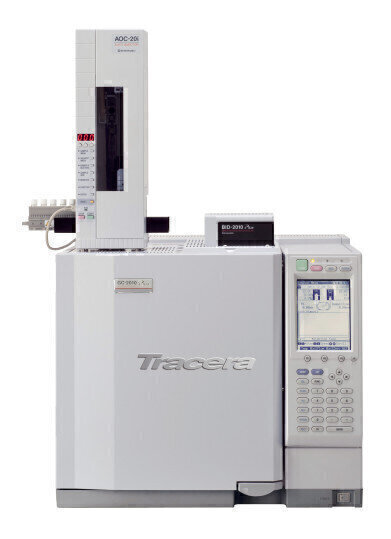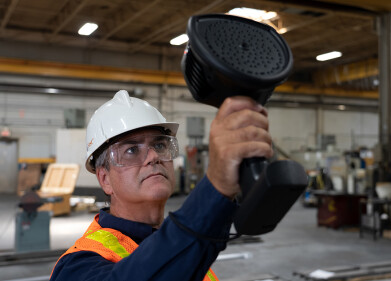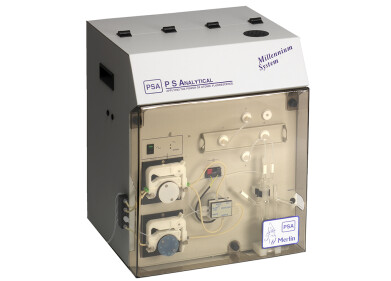Environmental laboratory
High-Sensitivity Gas Chromatograph Incorporates Novel Plasma Technology to Enable Trace Analysis
Mar 12 2013
Shimadzu Corporation (Germany) recently introduced the Tracera, a high-sensitivity gas chromatograph. Tracera is equipped with the newly developed barrier discharge ionisation detector (BID), which is capable of detecting all types of trace organic and inorganic compounds, with the exception of helium (He) and neon (Ne), at the 0.1 ppm level (i.e. sub-ppm, where ppm refers to parts per million). Tracera GC is applicable for many types of high-sensitivity analyses typically performed with GC systems incorporating different detectors.
Gas chromatographs are used for research & development and quality control in a number of fields, involving petrochemistry, fine chemicals, the environment, pharmaceuticals, foods, electronics/semiconductors, and fragrances. In recent years, demands for higher sensitivity and trace quantity analyses have increased. Examples include impurity analysis on the order of a few ppm for materials used in fine chemical products, and gas purity analysis for semiconductor manufacture.
Thermal conductivity detectors (TCD) and flame ionisation detectors (FID) are general-purpose detectors used in conventional gas chromatographs. A TCD detects a variety of inorganic and organic compounds, excluding the carrier gas component, but the sensitivity is insufficient. An FID is capable of detecting trace components at the ppm level, but can only detect organic compounds (excluding formaldehyde and formic acid). Analysis has thus required complex systems incorporating a variety of detectors to suit the target component.
With this issue in mind, Shimadzu has investigated the basics of plasma detection technology as a means for increasing sensitivity stability and the detectable concentration range. This has resulted in the barrier discharge ionisation detector (BID), a new detector capable of the high-sensitivity detection of both organic and inorganic compounds, while providing excellent durability.
“The Tracera is a ground breaking new system that combines this new type of detector, offering features not provided by conventional detectors, with the Shimadzu GC-2010 Plus high-performance capillary gas chromatograph,” Said Masahito Ueda, General Manager of GC & TA Business Unit, Analytical & Measuring Instruments Division. “It is expected to improve the efficiency of high-sensitivity, trace-quantity analyses, and to reduce equipment and analysis costs.”
The built-in barrier discharge ionisation detector (BID) generates helium plasma. The extremely high photon energy of this plasma ionises the sample components, enabling high-sensitivity detection. This system achieves at least 100 times the sensitivity of a conventional TCD, and at least twice the sensitivity of FID, enabling the detection of all types of trace components at the 0.1 ppm level.
The new BID helium plasma has an extremely high energy. It can detect all organic and inorganic compounds, with the exception of He and Ne, with no difference in sensitivity. It improves analysis sensitivity even with aldehydes, alcohols, and halides, for which sensitivity decreases with FID. A single Tracera system can perform analyses that conventionally required complicated systems equipped with multiple detectors and units. Examples include the analysis of hydrogen and organic compounds such as formic acid, generated as part of the reaction process during artificial photosynthesis, and the analysis of low concentration hydrocarbons and permanent gases generated in lithium ion rechargeable batteries.
With the new BID, the plasma is generated inside a quartz tube, so it makes no contact with the discharge electrode used for plasma generation. As a result, the detector electrode is not degraded, achieving long-term analytical stability.
Digital Edition
AET 28.4 Oct/Nov 2024
November 2024
Gas Detection - Go from lagging to leading: why investment in gas detection makes sense Air Monitoring - Swirl and vortex meters will aid green hydrogen production - Beyond the Stack: Emi...
View all digital editions
Events
Jan 20 2025 San Diego, CA, USA
Carrefour des Gestions Locales de L'eau
Jan 22 2025 Rennes, France
Safety, Health & Wellbeing LIVE
Jan 22 2025 Manchester, UK
Jan 25 2025 San Diego, CA, USA
Jan 29 2025 Tokyo, Japan



















